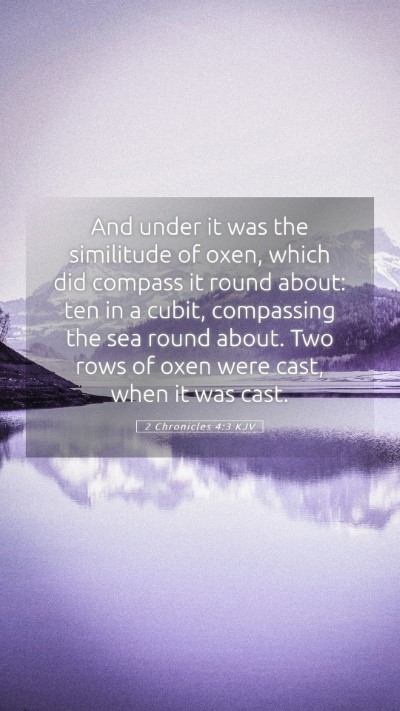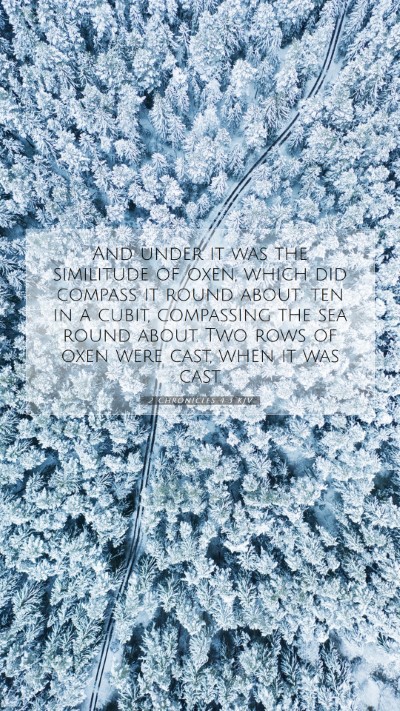Bible Verse Meaning: 2 Chronicles 4:3
Verse Reference: 2 Chronicles 4:3
2 Chronicles 4:3 describes the intricate design and significant features of the brazen sea that was made for the temple. This verse reads:
"And under it was the similitude of oxen, which did compass it round about: ten in a cubit, compassing the sea round about." (2 Chronicles 4:3)
Understanding the Verse
This verse is rich with symbolism and serves multiple purposes, both functional and theological. In the analysis of this scripture, we draw insights from various public domain commentaries to explore the deeper meanings.
Commentary Insights
-
Matthew Henry's Commentary:
Henry emphasizes the grandeur and craftsmanship of the brazen sea, highlighting its purpose in the temple for ceremonial washing. The oxen depicted under the sea symbolize strength and service, reflecting the nature of priests in their holy duties.
-
Albert Barnes' Notes:
Barnes focuses on the practicality of the brazen sea, specifically its function as a large basin for the priests to perform their washings. He notes that the design reflects God’s instruction for purity and holiness in worship.
-
Adam Clarke's Commentary:
Clarke notes the significance of the number and arrangement of the oxen, indicating the completeness and stability in the structure. He suggests that the use of large animal imagery communicates the weightiness of the temple’s sacrificial system and the seriousness of approaching God.
Spiritual Implications
The brazen sea serves as a powerful metaphor in the context of Christian theology. It reflects the necessity of spiritual cleansing before entering into God’s presence, which correlates with New Testament teachings on being washed clean by the blood of Christ. Furthermore, the imagery of oxen can symbolize the burdens we bear and the strength provided by God for service in His kingdom.
Historical Context
Understanding the historical backdrop of Israel’s temple worship can enhance our insight into this passage. The brazen sea was a significant architectural feature of Solomon’s temple and served as both a ritualistic basin and an impressive representation of Israel's devotion to God.
Cross References
- Exodus 30:18-21: Description of the bronze laver and the necessity of washing for priests.
- 1 Kings 7:23-26: A parallel account of the construction and dimensions of the brazen sea.
- Hebrews 10:22: Encouragement to draw near to God with a sincere heart and full assurance of faith, symbolizing the cleansing of our hearts.
Application of the Verse
In applying the meaning of 2 Chronicles 4:3 to daily life, we can reflect on what it means to be cleansed spiritually. Just as the priests were required to wash their hands and feet before ministering in the temple, we are reminded of the importance of repentance and seeking God's purification in our lives whenever we approach Him in worship or prayer.
Conclusion
In summary, 2 Chronicles 4:3 offers rich insights into both the ceremonial practices of ancient Israel and the broader spiritual truths applicable today. Through careful Bible study insights and commentary, we gain a deeper understanding of Scripture that encourages us to appreciate the significance of ritual purity and the strength we receive from God in service.


